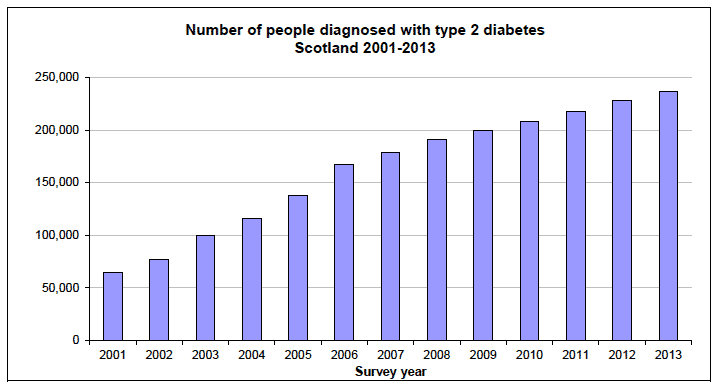Obesity Indicators 2014
This publication reports the latest available data for 16 indicators selected to monitor progress for the Prevention of Obesity Route Map. Most indicators are updated up to 2013, but for some indicators data is more or less up-to-date than this.
Prevalence of type 2 diabetes in Scottish population
Indicator Source: Scottish Diabetes Survey
LATEST RESULTS
- At the end of 2013, there were 268,154 people diagnosed with diabetes in Scotland recorded on local diabetes registers. This represented 5.0% of the population.
- 88.2% (236,605) of all cases were Type 2 diabetes.
- 55.0% of patients with a recorded BMI and type 2 diabetes were obese (BMI 30+), and a further 31.8% were overweight (BMI 25-30).
- Prevalence of type 2 diabetes continues to increase steadily[4].

ABOUT THIS INDICATOR
Desired Outcome:
Reduced mortality in obesity related disease.
Equalities:
Breakdowns by gender and age are included in the survey. Ethnic group is collected by the survey but subject to variable response rates and may require several years of data to be combined. Breakdowns by religion, disability and sexual orientation are not available.
Geography available:
National, Health Board from 2009.
Rationale for including this indicator:
The aim of this indicator is to monitor changes in the proportion of Scotland's population who have type 2 diabetes. The Scottish Public Health Observatory estimates that almost half of type 2 diabetes can be attributed to obesity. Diabetes is an important cause of disability and increases the risk of coronary heart disease and other health problems.
Type 2 diabetes is more common in deprived areas, and becomes much more common with increasing age. Overweight and obesity are also important risk factors: the risk of type 2 diabetes is around ten times higher among those with a BMI over 30 compared to those with a BMI under 30.
Factors influencing this indicator:
- Poor diet (specifically excess energy intake), low levels of physical activity, and the resulting increase in levels of obesity.
Contact
Email: Daniel Adams
There is a problem
Thanks for your feedback